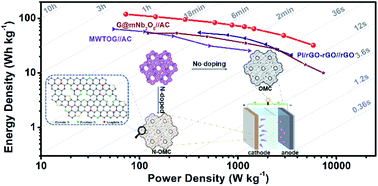Coupling anodic/cathodic energy storage through in situ heterostructure regulation of ordered microporous carbon for sodium-ion hybrid capacitors†
Abstract
Sodium-ion hybrid capacitors are emerging as promising energy storage and power output devices. However, they suffer from a sluggish faradaic reaction of the anode and low capacity of the cathode. Zeolite-templated carbons are a distinct class of ordered microporous carbon material, which have the characteristic properties related to electrochemical performance. Herein, we design two types of ordered microporous carbon (OMC) as the cathode and anode, which occupy different potential regions, through in situ heterostructure regulation for sodium-ion hybrid capacitors. The OMC has a relatively high graphite degree and expanded interlayer spacing, which can facilitate the storage of sodium ions as the anode. And nitrogen atoms are doped into the OMC framework to achieve nitrogen-doped ordered microporous carbon (N-OMC) as the cathode. The N-OMC not only has electric double layer capacity, but also has pseudocapacitive storage as a result of nitrogen doping. The resulting sodium-ion hybrid capacitor coupling two types of OMC achieves a high energy density of 119 W h kg−1, high power density of 5807 W kg−1, low capacity decay of 0.015% per cycle after 1800 cycles, and low self-discharge rate between 0.0 and 4.0 V. This result offers a feasible way to achieve electrodes derived from the same precursor and the fabrication of high-performance hybrid capacitors.

- This article is part of the themed collection: Journal of Materials Chemistry A HOT Papers


 Please wait while we load your content...
Please wait while we load your content...